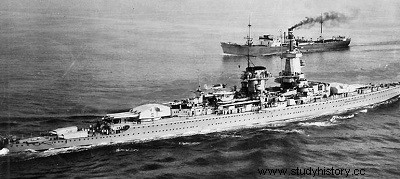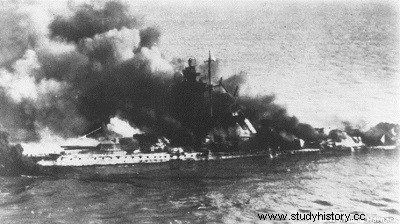
Sister ships of a three-ship class:Deutschland (plus later, Lutzow), the Graf Spee and the Scheer,
After the First World War, Germany no longer possessed any of the excellent dreadnoughts of the High Seas Fleet, but only a few old pre-dreadnoughts that could practically only be used for training. It was not authorized to build warships with a tonnage of more than 10,000 t and carrying artillery of more than 280 millimeters. The aim was to keep the German Navy at the level of the Scandinavian Marines, whose largest ships were small battleships armed with a few large guns for the defense of the coasts, called ships of the line for pure courtesy.
Germany's response to these restrictions was the creation of a new type of warship called the 'battleship', but more commonly known as the 'pocket battleship'. It was associated with the armament of an armored coastguard - two triple 280 mm turrets, torpedo tubes, secondary artillery of 150 mm - with a hull and the protection of an armored cruiser. Sensational innovation:the propulsion was provided by Diesel engines, which allowed the pocket battleships to reach a speed higher than that of the battleships of the time (lower, however, than the speed of the battleships and cruisers) and a radius of very respectable action (although less important than was claimed then). Certain other technical innovations, such as the extensive use of welding in construction, served to accredit the advertised standard displacement of 10,000 t, although in fact their displacement at full load was more than 50% higher than this figure. br class='autobr' /> 
The appearance of the three pocket battleships, the Deutschland (later , Lutzow), the Graf Spee and the Scheer, caused great emotion in maritime circles. They seemed like the perfect type of ocean-going corsair, faster than almost any ship strong enough to destroy it, but strong enough to take down almost any vessel fast enough to join it. In reality, they weren't as formidable as they seemed. Equipped with only two main turrets, it was difficult for them to engage more than one opponent at a time, a limitation which was to lead to the loss of Graf Spee at Rio de la Plata. They were also narrow and hardly better protected than contemporary cruisers armed with 203mm guns, but they benefited from the prestige of ships of the line.

GRAF SPEE
Normal movement , 12,100 t; fully loaded 16,200 t
Length 187.98 m overall
Width 21.64 m at main beam
Average draft , 5.79 m
Propulsion 2 shaft lines, 64,500 hp Diesel engines,
Speed 26 knots
Protection
cuirass belt , 101-038 mm;
bridges , 57 and 19 mm;
turrets , 14 and 12.7 mm
Artillery 6 pieces of 280 mm, 8 of 150 mm. 6 x 110 AA, 8 x 37 mm AA
L.T. Tubes 8 x 533 mm torpedo tubes
Launched June 30, 1934 at the Wilhelmshaven shipyards
